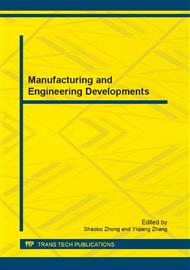[1]
E. Fishler, A. Haimovich, R. Blum, L. Cimini, D. Chizhik, and R. Valenzuela, MIMO radar: An idea whose time has come, in Proc. of the IEEE Intl. Conf on RADAR, p.71–78, Apr. (2010).
DOI: 10.1109/nrc.2004.1316398
Google Scholar
[2]
A. Haimovich, R. Blum, and L. Cimini, MIMO radar with widely separated antennas, IEEE Signal Processing Magazine, p.116–129, Jan. (2009).
DOI: 10.1109/msp.2008.4408448
Google Scholar
[3]
A. de Maio and M. Lops, Design principles of MIMO radar detectors, IEEE transactions on Aerospace and Electronic Systems, vol. 43, no. 3, p.886–898, (2007).
DOI: 10.1109/taes.2007.4383581
Google Scholar
[4]
J. Li, P. Stoica, and X. Zheng, Signal synthesis and receiver design for mimo radar imaging, IEEE transactions on Signal Processing, vol. 56, p.3959–3968, Aug. (2008).
DOI: 10.1109/tsp.2008.923197
Google Scholar
[5]
H. Deng, Polyphase code design for orthogonal netted radar, IEEE transactions on Signal Processing, vol. 52, p.3126–3135, Nov. (2004).
DOI: 10.1109/tsp.2004.836530
Google Scholar
[6]
B.M. Keel, J.M. Baden, and T.H. Heath, A comprehensive review of quasi–orthogonal waveforms, in 2007 IEEE Radar Conference, p.122–127, Apr. (2011).
DOI: 10.1109/radar.2007.374202
Google Scholar
[7]
S. Searle and S. Howard, A novel nonlinear technique for sidelobe suppression in radar, in Intl Conf. on Radar Systems, Oct. (2007).
DOI: 10.1049/cp:20070630
Google Scholar
[8]
S. Searle, S. Howard, and W. Moran, The formation of ambiguity functions with frequency seperated Golay coded pulses, to appear in IEEE trans. Aerospace & Electronic Systems, (2010).
DOI: 10.1109/taes.2009.5310320
Google Scholar
[9]
S. Searle and S. Howard, Doppler processing of square–complementary coded radar signals, in Intl. Conf. on Radar Systems, Sept. (2010).
DOI: 10.1109/radar.2008.4653902
Google Scholar
[10]
M. Parker, K. Paterson, and C. Tellambura, Golay complementary sequences, in Wiley Encyclopedia of Telecommunications (J. G. Proakis, ed. ), Wiley, (2003).
DOI: 10.1002/0471219282.eot367
Google Scholar
[11]
R. L. Frank, Polyphase complementary codes, IEEE trans. Info. Theory, vol. 26. 641–647, November (1980).
DOI: 10.1109/tit.1980.1056272
Google Scholar
[12]
S. Searle, S. Howard, and W. Moran, The use of complementary sets in MIMO radar, in Asilomar Conference on Signals, Systems and Computers, Oct. (2008).
DOI: 10.1109/acssc.2008.5074457
Google Scholar


